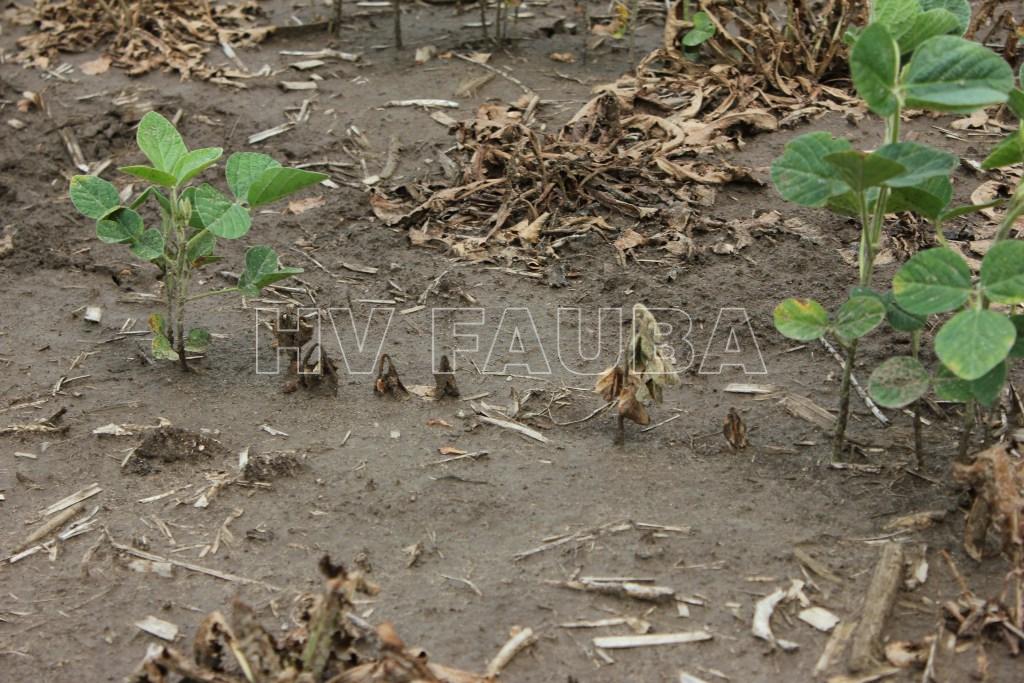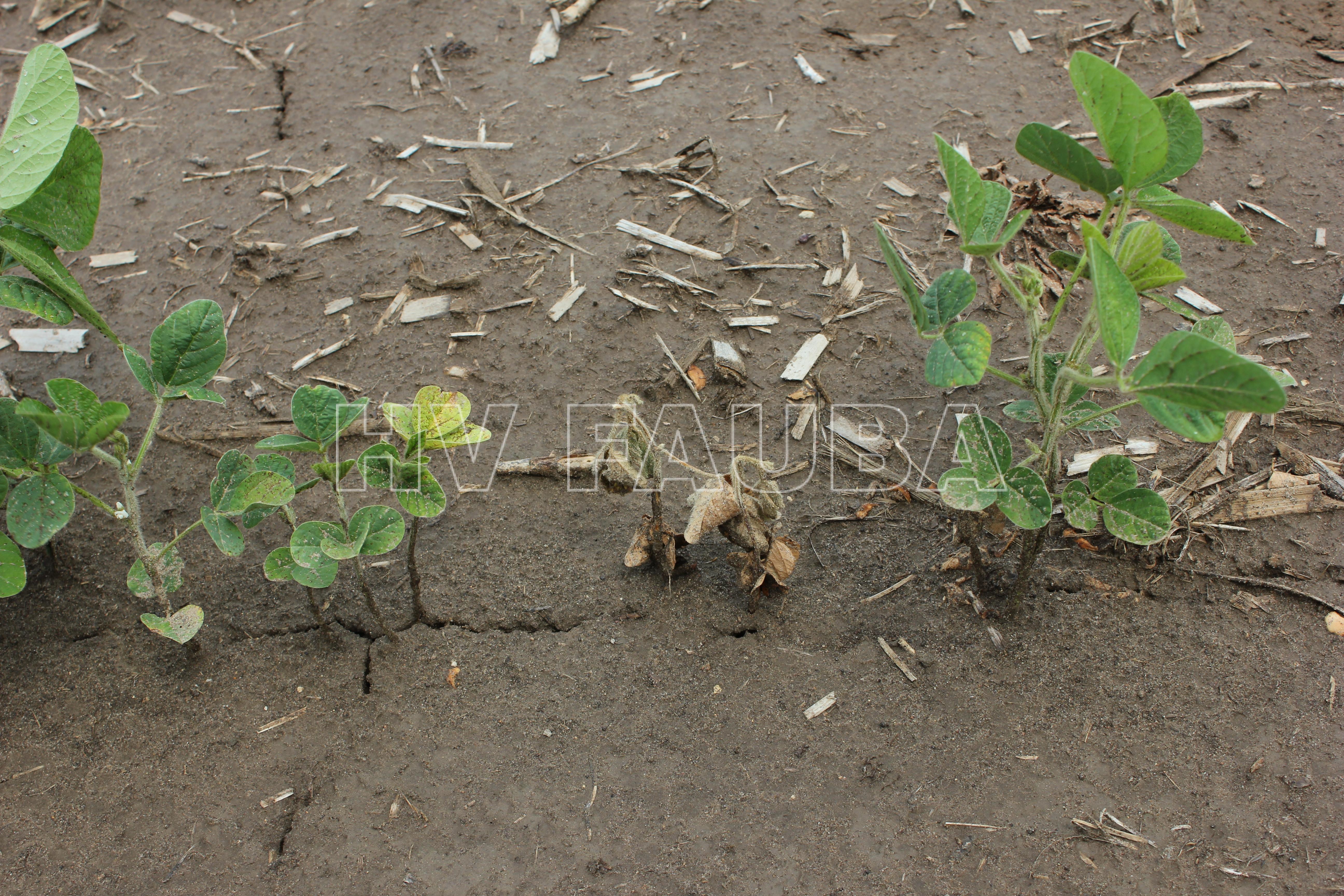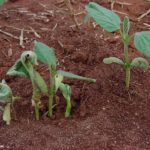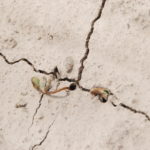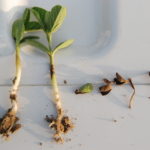.
Grupo de cultivos: Oleaginosas
Especie hospedante: Soja (Glycine max)
Epidemiología: monocíclica, aguda.
Etiología: Hongo. Necrotrófico
Agente causal: Los hongos frecuentemente aislados de plántulas afectadas son habitantes del suelo:
Fusarium solani, F. equiseti, F. oxysporum, Fusarium spp.
También pueden causar tizón, los hongos transmitidos por semillas como:
el complejo Diaporthe/Phomopsis,
.
.
.
.
Síntomas
Frecuentemente se observan lotes de soja con fallas en la germinación y muerte de semillas y de plántulas, tanto en pre como en post emergencia (Vc, VI, V2 hasta V3). Los ataques pueden producirse por inoculo presente en semillas, en el suelo y/o en rastrojos, provocando lesiones color castaño claro sobre raíces e hipocótilo, marchitamiento, podredumbre y tizón de plántulas. Las plántulas enfermas presentan síntomas de amarillamiento, luego se necrosan y mueren. Las condiciones de estrés hídrico favorecen el ataque de Fusarium spp.
.
- Síntomas del Tizón de plàntulas o Damping-off de la soja. Autor: Mary Chilvers, Michigan State University
- Damping off, pudrición de la raíz, tizón y muerte de plántulas de soja causado por Rhizoctonia. Autor: M. Chilvers.
.
Condiciones ambientales predisponentes para el establecimiento de la enfermedad
Esta enfermedad suele presentarse con condiciones de baja temperatura y/o alta humedad del suelo, que reducen la velocidad de germinación y emergencia de las plántulas. También predispone el ataque la baja calidad de semillas (por daño físico, daño mecánico, daño por chinche, daño por humedad, etc.).
.
- Las líneas de siembra con saltos pueden ser indicadores de la enfermedad de plántulas causadas por Pythium spp. Autor: Tom Allen, Mississippi State University
.
Manejo de la enfermedad
Estos hongos tienen numerosos huéspedes y sobreviven en los rastrojos y en el suelo, a través de estructuras de resistencia o saprofíticamente. Por lo tanto se recomienda utilizar semillas de buena calidad fisiológica, sanitaria y pureza físico-botánica; y tratarlas con fungicidas, lo cual aumenta el poder germinativo y el vigor de las plántulas, controlando patógenos y brindando protección durante la germinación. La siembra en condiciones ambientales favorables que permitan una emergencia rápida y uniforme (evitar las bajas temperaturas y el agua libre en el suelo y procurar una adecuada profundidad de siembra) determinan menores pérdidas. Rotación de cultivos (fundamentalmente con gramíneas).
.
- Tizón de plántulas de soja (Damping-off). Autor: Dirceu Gassen
- Plántulas de soja que sufrieron Damping-off post-emergencia. Autor: Tom Allen, Mississippi State University
- Notar las lesiones en los tallos de las plántulas, así como los síntomas de pre-emergencia causados por Damping off. Autor: Tom Allen, Mississippi State University
.
Bibliografía
Ajayi-Oyetunde OO, Bradley CA (2018) Rhizoctonia solani: taxonomy, population biology and management of rhizoctonia seedling disease of soybean. Plant Pathology 67: 3–17. doi: 10.1111/ppa.12733
Alfiky A, L’Haridon F, Abou-Mansour E, Weisskopf L (2022) Disease inhibiting effect of strain Bacillus subtilis EG21 and its metabolites against potato pathogens Phytophthora infestans and Rhizoctonia solani. Phytopathology. doi: 10.1094/PHYTO-12-21-0530-R
JN (2021) Mycoparasitic Pseudomonas spp. against infection of Fusarium chlamydosporum pathogen in soyabean (Glycine max) plant. Archives of Phytopathology and Plant Protection. doi: 10.1080/03235408.2021.1925433
Bai L, Cui J, Jie W, Cai B (2015) Analysis of the community compositions of rhizosphere fungi in soybeans continuous cropping fields. Microbiological Research 180: 49-56. doi: 10.1016/j.micres.2015.07.007.
Bates GD, Rothrock CS, Rupe JC (2008) Resistance of the soybean cultivar Archer to Pythium damping-off and root rot caused by several Pythium spp. Plant Disease 92: 763-766. doi: 10.1094/PDIS-92-5-0763
Bakker MG, Brown DW, Kelly AC, Kim HS, Kurtzman CP, Mccormick SP (2018) Fusarium mycotoxins: a trans-disciplinary overview. Canadian Journal of Plant Pathology 40(2): 161-171. doi: 10.1080/07060661.2018.1433720
, , , et al. (2020) Towards a best practice methodology for the detection of Phytophthora species in soils. Plant Pathology 00: 1– 11. doi: 10.1111/ppa.13312
Carmona MA, Sautua FJ, Grijalba PE, Cassina M, Pérez‐Hernández O (2018) Effect of potassium and manganese phosphites in the control of Pythium damping‐off in soybean: a feasible alternative to fungicide seed treatments. Pest Management Science 74: 366-374. doi: 10.1002/ps.4714
Cerritos Garcia DG, Huang SY, Kleczewski NM, Mideros S (2022) Virulence, Aggressiveness, and Fungicide Sensitivity of Phytophthora spp. Associated with Soybean in Illinois. Plant Disease. doi: 10.1094/PDIS-07-22-1551-RE
Chi SI, Akuma M, Xu R, et al. (2024) Phenazines are involved in the antagonism of a novel subspecies of Pseudomonas chlororaphis strain S1Bt23 against Pythium ultimum. Sci Rep 14, 20517. doi: 10.1038/s41598-024-71418-y
Clevinger EM, Biyashev R, Lerch-Olson E, et al. (2021) Identification of Quantitative Disease Resistance Loci Toward Four Pythium Species in Soybean. Front Plant Sci. 12: 644746. doi: 10.3389/fpls.2021.644746
Delgado-Baquerizo, M., Guerra, C.A., Cano-Díaz, C. et al. (2020) The proportion of soil-borne pathogens increases with warming at the global scale. Nat. Clim. Chang. 10, 550–554. https://doi.org/10.1038/s41558-020-0759-3
Díaz Arias MM, Munkvold GP, Ellis ML, Leandro LFS (2013) Distribution and frequency of Fusarium species associated with soybean roots in Iowa. Plant Disease 97: 1557-1562. doi: 10.1094/PDIS-11-12-1059-RE
Díaz Arias MM, Leandro LF, Munkvold GP (2013) Aggressiveness of Fusarium species and impact of root infection on growth and yield of soybeans. Phytopathology 103: 822-832. doi: 10.1094/PHYTO-08-12-0207-R
de Cock AW, Lodhi AM, Rintoul TL, Bala K, Robideau GP, Abad ZG, Coffey MD, Shahzad S, Lévesque CA (2015) Phytopythium: molecular phylogeny and systematics. Persoonia 34: 25-39. doi: 10.3767/003158515X685382
Delgado-Baquerizo, M., Guerra, C.A., Cano-Díaz, C. et al. (2020) The proportion of soil-borne pathogens increases with warming at the global scale. Nat. Clim. Chang. 10, 550–554. doi: 10.1038/s41558-020-0759-3
Dorrance AE, Berry SA, Lipps PE (2004) Characterization of Pythium spp. from Three Ohio Fields for Pathogenicity on Corn and Soybean and Metalaxyl Sensitivity. Plant Health Progress 5:1. doi: 10.1094/PHP-2004-0202-01-RS
Dorrance AE, Kleinhenz MD, McClure SA, Tuttle NT (2003) Temperature, moisture, and seed treatment effects on Rhizoctonia solani root rot of soybean. Plant Disease 87: 533-538. doi: 10.1094/PDIS.2003.87.5.533
Dorrance AE, Kurle J, Robertson AE, Bradley CA, Giesler L, Wise K Concibido VC (2016) Pathotype Diversity of Phytophthora sojae in Eleven States in the United States. Plant Disease 100(7): 1429-1437. doi: 10.1094/PDIS-08-15-0879-RE
Dorrance AE, Vargas A, Navarro-Acevedo K, et al. (2024) Picarbutrazox effectiveness added to a seed treatment mixture for management of Oomycetes that impact soybean in Ohio. Plant Dis. doi: 10.1094/PDIS-06-23-1223-RE
Eggertson QA, Rintoul TL, Lévesque CA (2023) Resolving the Globisporangium ultimum (Pythium ultimum) species complex. Mycologia: 1-19. doi: 10.1080/00275514.2023.2241980
El-Abdean WZ, Abo-Elyousr KAM, Hassan MHA, El-Sheakh MM (2013) Molecular characterization of Rhizoctonia solani isolates the incitant of soybean root rot. Archives Of Phytopathology And Plant Protection 46(9): 1108-1117. doi: 10.1080/03235408.2012.759407
Ellis ML, Cruz Jimenez DR, Leandro LF, Munkvold GP (2014) Genotypic and phenotypic characterization of fungi in the Fusarium oxysporum species complex from soybean roots. Phytopathology 104: 1329-1339. doi: 10.1094/PHYTO-02-14-0043-R
, , , et al. (2020) Pathogenicity and fungicide sensitivity of Pythium and Phytopythium spp. associated with soybean in the Huang‐Huai region of China. Plant Pathology 69: 1083– 1092. doi: 10.1111/ppa.13187
Gao RF, Wang JY, Liu KW, et al. (2021) Comparative analysis of Phytophthora genomes data. Data Brief. 39: 107663. doi: 10.1016/j.dib.2021.107663
Ghissi VV, Reis EM, Deuner CC (2014) Etiology of Phomopsis root rot in soybean. Summa Phytopathologica 40(3): 270-272. doi: 10.1590/0100-5405/1966
Griffin GJ (1990) Importance of Pythium ultimum in a disease syndrome of cv. Essex Soybean. Canadian Journal of Plant Pathology 12(2): 135-140. doi: 10.1080/07060669009501016
Grijalba PE, Gally ME (2015) Virulence of Phytophthora sojae in the Pampeana Subregion of Argentina from 1998 to 2004. Journal of Phytopathology 163(9): 723–730. doi: 10.1111/jph.12369
Grijalba PE, Ridao Ad, Steciow MM (2021) Oomycetes species associated with soybean in Buenos Aires Province (Argentina). Phytoparasitica. doi: 10.1007/s12600-021-00921-z
Hameeda B, Harini G, Rupela OP, et al. (2010) Biological Control of Chickpea Collar Rot by Co-inoculation of Antagonistic Bacteria and Compatible Rhizobia. Indian J Microbiol 50, 419–424. doi: 10.1007/s12088-011-0083-8
Harikrishnan R, Yang XB (2002) Effects of herbicides on root rot and damping-off caused by Rhizoctonia solani in glyphosate-tolerant soybean. Plant Disease 86: 1369-1373. doi: 10.1094/PDIS.2002.86.12.1369
Harvey PR, Warren RA, Wakelin S (2008) The Pythium–Fusarium root disease complex – an emerging constraint to irrigated maize in southern New South Wales. Australian Journal of Experimental Agriculture 48(3): 367-374. doi: 10.1071/EA06091
Hebb L, Bradley CA, Telenko DEP, et al. (2023) Isolates of Phytophthora sansomeana Display a Range of Aggressiveness on Soybean Seedlings. Plant Health Progress. doi: 10.1094/PHP-08-22-0075-RS
Hosseini B, Voegele RT, Link TI (2023) Diagnosis of Soybean Diseases Caused by Fungal and Oomycete Pathogens: Existing Methods and New Developments. J Fungi (Basel) 9(5):587. doi: 10.3390/jof9050587
Hudge BV (2015) Management of damping-off disease of soybean caused by Pythium ultimum Trow. Int.J.Curr.Microbiol.App.Sci 4(1): 799-808. ISSN: 2319-7706
Jiang YN, Haudenshield JS, Hartman GL (2012) Characterization of Pythium spp. from soil samples in Illinois. Canadian Journal of Plant Pathology 34(3): 448-454. doi: 10.1080/07060661.2012.705326
Jose A, Anitha Sasidharan S, Chacko C, et al. (2021) Activity of Clove Oil and Chitosan Nanoparticles Incorporated PVA Nanocomposite Against Pythium aphanidermatum. Appl Biochem Biotechnol. doi: 10.1007/s12010-021-03709-3
Kasteel M, Ketelaar T, Govers F (2023) Fatal attraction: How Phytophthora zoospores find their host. Semin Cell Dev Biol. 148-149: 13-21. doi: 10.1016/j.semcdb.2023.01.014
Kato M, Minamida K, Tojo M, et al. (2013) Association of Pythium and Phytophthora with Pre-emergence Seedling Damping-off of Soybean Grown in a FieldConverted from a Paddy Field in Japan. Plant Production Science 16: 95-104. doi: 10.1626/pps.16.95
Kaur R, Kalia A, Lore JS, Kaur A, Yadav I, Sharma P, Sandhu JS (2021) Trichoderma sp. endochitinase and β‐1,3‐glucanase impede Rhizoctonia solani growth independently, and their combined use does not enhance impediment. Plant Pathol. doi: 10.1111/ppa.13381
Kronmiller BA, Feau N, Shen D, et al. (2023) Comparative Genomic Analysis of 31 Phytophthora Genomes Reveals Genome Plasticity and Horizontal Gene Transfer. Mol Plant Microbe Interact. 36(1): 26-46. doi: 10.1094/MPMI-06-22-0133-R
Kurm V, Visser J, Schilder M, et al. (2023) Soil Suppressiveness Against Pythium ultimum and Rhizoctonia solani in Two Land Management Systems and Eleven Soil Health Treatments. Microb Ecol 86: 1709–1724. doi: 10.1007/s00248-023-02215-9
Lamichhane JR, Dürr C, Schwanck AA, et al. (2017) Integrated management of damping-off diseases. A review. Agronomy for Sustainable Development 37: 10. doi: 10.1007/s13593-017-0417-y
Lamichhane JR, Aubertot JN (2021) Effect of Early and Conventional Sowings on Soybean Establishment Quality, Nodulation, and Early Biomass Development Under Inoculation with Rhizoctonia solani. PhytoFrontiers™ 1: 205-218. doi: 10.1094/PHYTOFR-12-20-0046-R
Legrifi I, Al Figuigui J, El Hamss H, et al. (2022) Potential for Biological Control of Pythium schmitthenneri Root Rot Disease of Olive Trees (Olea europaea L.) by Antagonistic Bacteria. Microorganisms 10(8): 1635. doi: 10.3390/microorganisms10081635
Lévesque CA, Brouwer H, Cano L, et al. (2010) Genome sequence of the necrotrophic plant pathogen Pythium ultimum reveals original pathogenicity mechanisms and effector repertoire. Genome Biol 11: R73. doi: 10.1186/gb-2010-11-7-r73
Li S, Hartman GL (2003) Molecular detection of Fusarium solani f. sp. glycines in soybean roots and soil. Plant Pathology 52: 74–83. doi: 10.1046/j.1365-3059.2003.00797.x
Lin F, Li W, McCoy AG, et al. (2022) Identification and characterization of pleiotropic and epistatic QDRL conferring partial resistance to Pythium irregulare and P. sylvaticum in soybean. Theor Appl Genet. doi: 10.1007/s00122-022-04201-0
Liu Y, He P, He P, et al. (2022) Potential biocontrol efficiency of Trichoderma species against oomycete pathogens. Front Microbiol. 13: 974024. doi: 10.3389/fmicb.2022.974024
Lookabaugh EC, Kerns JP, Cubeta MA, Shew BB (2018) Fitness Attributes of Pythium aphanidermatum with Dual Resistance to Mefenoxam and Fenamidone. Plant Dis. 102(10): 1938-1943. doi: 10.1094/PDIS-01-18-0043-RE
Marburger DA, Smith DL, Conley SP (2017) Impact of Fusarium graminearum on early-season soybean growth and seed yield under field conditions. Canadian Journal of Plant Pathology 39(4): 464-474. doi: 10.1080/07060661.2017.1378727
Marchand G, Chen Y, Berhane NA, et al. (2014) Identification of Pythium spp. from the rhizosphere of soybeans in Ontario, Canada. Canadian Journal of Plant Pathology 36(2): 246-251. doi: 10.1080/07060661.2014.920921
Matthiesen RL, Ahmad AA, Robertson AE (2016) Temperature affects aggressiveness and fungicide sensitivity of four Pythium spp. that cause soybean and corn damping off in Iowa. Plant Disease 100(3): 583-591. doi: 10.1094/PDIS-04-15-0487-RE
Matthiesen RL, Robertson AE (2023) Effect of infection timing by four Pythium spp. on soybean damping-off symptoms with and without cold stress. Plant Dis. doi: 10.1094/PDIS-01-23-0082-RE
Miao J, Liu X, Du X, Li G, Li C, Zhao D, Liu X (2020) Sensitivity of Pythium spp. and Phytopythium spp. and tolerance mechanism of Pythium spp. to oxathiapiprolin. Pest Management Science 76: 3975-3981. https://doi.org/10.1002/ps.5946
Modrzewska M, Bryła M, Kanabus J, Pierzgalski A (2022) Trichoderma as a biostimulator and biocontrol agent against Fusarium in the production of cereal crops: opportunities and possibilities. Plant Pathol. doi: 10.1111/ppa.13578
Molin C, Ribeiro NR, Matsumoto MN, et al. (2021) Damping‐off of soybean in southern Brazil can be associated with different species of Globisporangium spp. and Pythium spp. Plant Pathol. Accepted Author Manuscript. doi: 10.1111/ppa.13397
Navarro-Acevedo KA, Wijeratne S, Culman SW, et al. (2021) The Effect of Incubation Temperature on the Species Composition of Phytophthora, Phytopythium, and Pythium Communities Associated with Soybean. Phytobiomes Journal 5: 133-144. doi: 10.1094/PBIOMES-01-20-0016-R
Navarro KA, Wijeratne S, Culman S, et al. (2021) Comparison of the Species Communities of Phytophthora, Pythium, and Phytopythium Associated with Soybean Genotypes in High Disease Environments in Ohio. Phytobiomes Journal 5: 288-304. doi: 10.1094/PBIOMES-12-20-0089-R
Navi SS, Huynh T, Mayers CG, et al. (2019) Diversity of Pythium spp. associated with soybean damping-off, and management implications by using foliar fungicides as seed treatments. Phytopathology Research 1: 8. https://doi.org/10.1186/s42483-019-0015-9
Nguyen HDT, Dodge A, Dadej K, et al. (2022) Whole genome sequencing and phylogenomic analysis show support for the splitting of genus Pythium. Mycologia 6:1-15. doi: 10.1080/00275514.2022.2045116
O’Donnell K, Whitaker BK, Laraba I, et al. (2022) DNA Sequence-Based Identification of Fusarium: A Work in Progress. Plant Disease 106(6): 1597-1609. doi: 10.1094/PDIS-09-21-2035-SR
Panda A, Sen D, Ghosh A, Gupta A, Mathu Malar C, Prakash Mishra G, Singh D, Ye W, Tyler BM, Tripathy S (2018) EumicrobeDBLite: a lightweight genomic resource and analytic platform for draft oomycete genomes. Molecular Plant Pathology 19: 227–237. doi: 10.1111/mpp.12505
Panth M, Hassler SC, Baysal-Gurel F (2020) Methods for Management of Soilborne Diseases in Crop Production. Agriculture 10: 16. doi: 10.3390/agriculture10010016
Petrovic K, Skaltsas D, Castlebury L, et al. (2020) Diaporthe seed decay of soybean [Glycine max (L.) Merr.] is endemic in the United States, but new fungi are involved. Plant Disease. doi: 10.1094/PDIS-03-20-0604-RE
Pimentel MF, Arnao E, Warner AJ, et al. (2022) Reduction of Pythium Damping-off in Soybean by Biocontrol Seed Treatment. Plant Disease. doi: 10.1094/PDIS-06-21-1313-RE
Radmer L, Anderson G, Malvick DM, et al. (2017) Pythium, Phytophthora, and Phytopythium spp. Associated with Soybean in Minnesota, Their Relative Aggressiveness on Soybean and Corn, and Their Sensitivity to Seed Treatment Fungicides. Plant Disease 101(1): 62-72. doi: 10.1094/PDIS-02-16-0196-RE
Reyes Gaige A, Giraldo M, Todd T, Stack J (2018) Growth and colonization of organic matter in soil by Fusarium proliferatum. Canadian Journal of Plant Pathology. doi: 10.1080/07060661.2018.1522374
Roberts DP, Selmer K, Lupitskyy R, et al. (2021) Seed treatment with prodigiosin controls damping-off of cucumber caused by Pythium ultimum. AMB Express 11(1): 10. doi: 10.1186/s13568-020-01169-2
Rojas AJ, Jacobs JL, Napieralski S, et al. (2017) Oomycete Species Associated with Soybean Seedlings in North America—Part I: Identification and Pathogenicity Characterization. Phytopathology 107(3): 280-292. doi: 10.1094/PHYTO-04-16-0177-R
Rojas A, Jacobs JL, Napieralski S, et al. (2017) Oomycete species associated with soybean seedlings in North America – Part II: Diversity and Ecology in Relation to Environmental and Edaphic Factors. Phytopathology 107: 293–304. doi: 10.1094/PHYTO-04-16-0176-R
Rupe JC, Rothrock CS, Bates G, Rosso ML, Avanzato MV, Chen P (2011) Resistance to Pythium Seedling Disease in Soybean. pp 261- In: Sudaric A (Ed.) Soybean – Molecular Aspects of Breeding. InTech. doi: 10.5772/15301
Sartori FF, Pimpinato FR, Tornisielo VL, Dieminger Engroff T, de Souza Jaccoud‐Filho D, Menten JO, Dorrance AE, Dourado‐Neto D (2020) Soybean seed treatment: how do fungicides translocate in plants?. Pest Management Science 76: 2355-2359. doi: 10.1002/ps.5771
Scott K, Eyre M, McDuffee D, Dorrance AE (2020) The Efficacy of Ethaboxam as a Soybean Seed Treatment Toward Phytophthora, Phytopythium, and Pythium in Ohio. Plant Disease 104(5): 1421-1432. doi: 10.1094/PDIS-09-19-1818-RE
Serrano M, McDuffee D, Robertson AE (2018) Damping-off caused by Pythium sylvaticum on soybeans subjected to periods of cold stress is reduced by seed treatments. Canadian Journal of Plant Pathology. doi: 10.1080/07060661.2018.1522516
Siebatcheu EC, Wetadieu D, Youassi Youassi O, et al. (2022) Secondary metabolites from an endophytic fungus Trichoderma erinaceum with antimicrobial activity towards Pythium ultimum. Nat Prod Res. 1-6. doi: 10.1080/14786419.2022.2075360
Stewart S, Abeysekara N, Robertson AE (2014) Pathotype and genetic shifts in a population of Phytophthora sojae under soybean cultivar rotation. Plant Disease 98: 614-624. doi: 10.1094/PDIS-05-13-0575-RE
Sugano, S., Sugimoto, T., Takatsuji, H. and Jiang, C.‐J. (2013) Induction of resistance to Phytophthora sojae in soyabean (Glycine max) by salicylic acid and ethylene. Plant Pathol, 62: 1048-1056. doi: 10.1111/ppa.12011
Sugimoto T, Watanabe K, Yoshida S, et al. (2010) Field application of calcium to reduce Phytophthora stem rot of soybean, and calcium distribution in plants. Plant Dis. 94: 812–819. doi: 10.1094/PDIS-94-7-0812
Tu CK, Wang PH, Lee MH (2022) The endophytic bacterium Lysobacter firmicutimachus strain 5-7 is a promising biocontrol agent against rice seedling disease caused by Pythium arrhenomanes in nursery trays. Plant Dis. doi: 10.1094/PDIS-05-22-1195-RE
Veterano ST, Coffua LS, Mena-Ali JI, Blair JE (2017) Pythium yorkensis sp. nov., a potential soybean pathogen from southeastern Pennsylvania, USA. Plant Pathology (accepted). doi: 10.1111/ppa.12779
Wang M, Van Vleet S, McGee R, et al. (2021) Chickpea Seed Rot and Damping-Off Caused by Metalaxyl-Resistant Pythium ultimum and Its Management with Ethaboxam. Plant Disease 105(6): 1728-1737. doi: 10.1094/PDIS-08-20-1659-RE
Wang M, Du Y, Ling C, et al. (2021) Design, Synthesis and Antifungal/Anti‐Oomycete Activity of Pyrazolyl Oxime Ethers as Novel Potential Succinate Dehydrogenase Inhibitors. Pest Manag Sci. Accepted Author Manuscript. doi: 10.1002/ps.6418
Wang N, Yin Z, Wu Y, et al. (2023) A Pythium myriotylum Small Cysteine-Rich Protein Triggers Immune Responses in Diverse Plant Hosts. Mol Plant Microbe Interact.: MPMI09220187R. doi: 10.1094/MPMI-09-22-0187-R
Zitnick-Anderson KK, Nelson BDJr (2015) Identification and pathogenicity of Pythium on soybean in North Dakota. Plant Disease 99(1): 31-38. doi: 10.1094/PDIS-02-14-0161-RE
